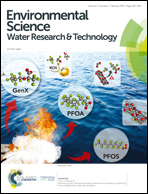Integrity of reverse osmosis membrane for removing bacteria: new insight into bacterial passage†
Abstract
Water quality and reliability during potable reuse can often depend on the performance of the reverse osmosis (RO) membrane treatment for the attenuation of microbial contaminants. This pilot-scale study aimed to assess the passage of bacteria through the intact RO membrane element and O-ring seal using stable fluorescent (FL) microspheres as surrogates for bacteria and fluorescently stained bacteria. The removal of FL microspheres by three low pressure RO membrane elements varied considerably from 3.1 to 5.0 log (99.92% to 99.999%). O-Ring seal bonding at the interface between RO feed and permeate streams increased the removal of FL microspheres by 0.2 to 0.4 log and the removal of actual bacteria in reclaimed water by 0.5 log. The results also show that conductivity is not a suitable surrogate parameter to monitor bacterial removal by these RO membranes. Overall, this study identified that even the intact O-ring seal can allow for some bacterial passage and the O-ring seal can be a source of low RO performance for bacterial removal. This study suggested the potential that the improvement of O-ring sealing performance can increase bacterial removal by 0.5 log.



 Please wait while we load your content...
Please wait while we load your content...